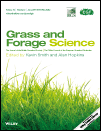Ver ítem
- xmlui.general.dspace_homeCentros Regionales y EEAsCentro Regional Buenos Aires NorteEEA PergaminoArtículos científicosxmlui.ArtifactBrowser.ItemViewer.trail
- Inicio
- Centros Regionales y EEAs
- Centro Regional Buenos Aires Norte
- EEA Pergamino
- Artículos científicos
- Ver ítem
Is the nutritive value of tall fescue (Festuca arundinacea Schreb.) related to the accumulated forage mass?
Resumen
The aim of this work was to investigate whether neutral detergent fibre (NDF) and dry‐matter digestibility (DMD) are related to tall fescue accumulated forage mass (AFM) and to assess the relevance of environmental variables to predict the nutritive value of tall fescue swards. Three experiments were carried out in Pergamino, Argentina. To obtain swards with different amounts of AFM, two N levels and two irrigation regimes were applied in the spring after
[ver mas...]
The aim of this work was to investigate whether neutral detergent fibre (NDF) and dry‐matter digestibility (DMD) are related to tall fescue accumulated forage mass (AFM) and to assess the relevance of environmental variables to predict the nutritive value of tall fescue swards. Three experiments were carried out in Pergamino, Argentina. To obtain swards with different amounts of AFM, two N levels and two irrigation regimes were applied in the spring after sowing and the autumn of the next year. In spring and autumn, AFM, NDF and DMD were measured every 10–12 days. In spring, NDF increased from 503 to 604 g kg−1, DMD decreased from 684 to 558 g kg−1 and AFM increased from 0·64 to 2·82 t DM ha−1. In autumn, NDF decreased from 543 to 442 g kg−1, DMD increased from 591 to 681 g kg−1 and AFM increased from 0·35 to 1·10 t DM ha−1. The results show that the nutritive value of tall fescue through the year is not related to the accumulation of dry matter of the sward. Nutritive value is determined by the reproductive stage in late spring and early summer, the fate of photosynthates at different times of the year and the synthesis of non‐digestible compounds.
[Cerrar]

Autor
Fuente
Grass and Forage Science 71 (1) : 102-111 (March 2016)
Fecha
2016-03
Editorial
Wiley
ISSN
0142-5242
1365-2494
1365-2494
Formato
pdf
Tipo de documento
artículo
Palabras Claves
Derechos de acceso
Restringido
 Excepto donde se diga explicitamente, este item se publica bajo la siguiente descripción: Creative Commons Attribution-NonCommercial-ShareAlike 2.5 Unported (CC BY-NC-SA 2.5)
Excepto donde se diga explicitamente, este item se publica bajo la siguiente descripción: Creative Commons Attribution-NonCommercial-ShareAlike 2.5 Unported (CC BY-NC-SA 2.5)

